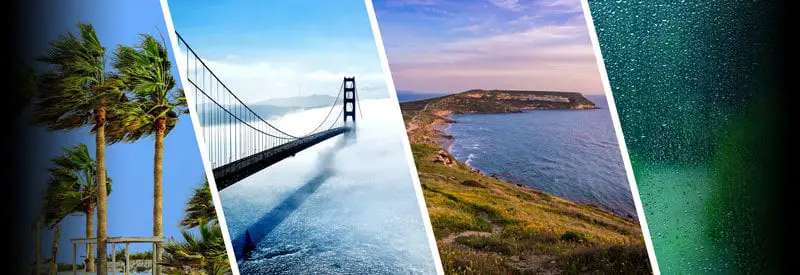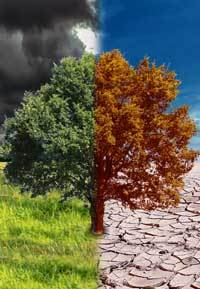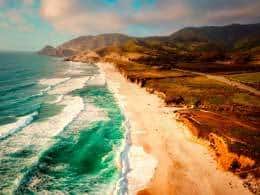What The Weather Is Like In A Coastal Region & Why It Has A Moderate Climate

If you live on the coast or just visit it occasionally, you quickly tend to notice a change in local weather conditions. And as you would have noticed, the weather differs significantly from that of inland regions.
A coastal region is defined and characterized by mild weather conditions since it experiences warmer winters and cooler summers than a region situated inland. This is a result of ocean temperatures taking longer to warm up during summer and cool down during winter than the adjacent landmass.
Coastal regions have a distinctly unique climate, with weather patterns that are similar across most cities, towns, and rural areas around the world where land meets the sea.
Not all coastal regions are the same, though. The Maldives near the Equator has a vastly different climate from the Lofoten Islands in Norway near the Arctic Circle.
The coastal regions we will be focusing on are all located in more temperate climate zones where the vast majority of the world's coastal population is concentrated.
You might have noticed that the terms climate and weather have already been used several times in just the first few sentences of this article. These two terms remain confusing or misunderstood by many readers, so it is important to clarify them before continuing:
The Difference Between Climate And Weather

Although they both focus on atmosphere conditions, the biggest difference between climate and weather can be summed in one word: Time!
Climate is the weather patterns and averages of a region established over a sustained period, usually 30 years or more. Weather, though, is the actual atmospheric conditions of a location you experience hour by hour and day by day.
This short explanation will help to clear up any remaining confusion about how these two similar but different terminologies relate to each other. If you are still unsure, you can get more in-depth information on the difference between weather and climate in this article.
We can now turn our attention to the climate of a coastal area and the associated weather conditions you are likely to experience. Before delving into the characteristics of its climate, it is important to make sure there is a clear understanding of what a coastal region is.
What Is A Coastal Region?
The name coastal region (also known as a coastal zone) can be a bit vague for some, as it does not pinpoint a specific location and is mostly a transitional area. The following definition will help to clarify this term.

A coastal region refers to the border or transitional area where land meets the ocean. This area includes locations on the coast itself, but also areas marginally further inland which experience weather still directly influenced by the sea.
Some definitions include the borders between land and large inland lakes, but to clearly define a Coastal Climate, our focus will remain on the boundary between land and ocean. (The varying sizes of inland bodies of water may negate the effect of actual coastal weather.)
The Climate Of A Coastal Region
The climate of a coastal region is characterized by several weather conditions, which combine to form atmospheric conditions that are unique to areas in and around the coast.
The best way to describe a Coastal Climate is to first list the various weather conditions that define it and then look at each one in more detail. The primary weather conditions that are associated with a coastal region are:
- Sea Breeze During The Day
- Land Breeze In The Evenings
- Moderate Climate Throughout The Year
- Coastal Fog
- Higher Rainfall Than Inland Areas
These characteristics are typical weather conditions you will find at the coast in temperate clime zones. There are obvious exceptions to the rules, especially in regions situated at higher latitudes and closer to the Tropics.
Coastal regions where a desert meets the ocean can also have a vastly different climate. For example, the Skeleton Coast in the Namib Desert and the Atacama Desert in Chile are some of the driest regions in the world. These are exceptions to the rule, though.
1) Sea Breeze During The Day
A sea breeze, much like the majority of weather conditions experienced at the coast, is the result of the contrasting way in which the land and ocean react to changes in temperature.

During the day, both the land and ocean warm up, but the land warms up much faster than the ocean water. As you will soon discover, it is important to note that even though the ocean takes longer to warm up, it is also able to retain the heat much longer than the land.
As the land warms up, it heats the air at the surface. The warm air rises and expands, which leaves less air at the surface, creating a low-pressure system over land. Since water over the ocean takes longer to warm up, it allows the air above it to maintain a higher pressure.
Since air always flows from a high-pressure system to a low-pressure system, the air from the ocean flows to the land. This forms the sea breeze we are so familiar with, which usually occurs during the afternoons and early evenings.
Depending on the contrast in temperature between land and sea, the wind blowing from the ocean may vary from a light breeze to relatively strong gusty winds.
2) Land Breeze In The Evenings
During the evening, the opposite occurs. The land cools off much faster than the ocean, which retains the heat absorbed during the day much longer. (The reason why I highlighted this ability of the ocean in the previous section.)
As a result, the colder air over land forms a high-pressure system, while the warm air over the ocean water rises and creates a low-pressure system.
The wind now blows from the high-pressure area over land to the low-pressure area over the sea. This is how a land breeze is formed, which usually occurs late in the evening and the early hours of the morning.
To find out how high and low-pressure systems are formed and how they influence the weather, you can read more about it in this article.
3) Moderate Climate Throughout The Year
The fact that the ocean takes much longer to warm up than land, and its ability to retain heat much longer than as well, do not just play a role in the creation of land and sea breezes but are also responsible for the moderate climate of coastal regions.
During the summer season, the air temperature over land warms up fairly quickly, while the ocean remains relatively cold since it takes longer to absorb the heat. During the winter months, the land cools down faster than the ocean, which is able to retain its heat longer.
This results in cooler air moving in from the ocean during the summer and warmer air over the sea that is blown inland during the winter months. This creates a more moderate climate where the summers are cooler and the winters milder than inland regions.
Please note that the moderate climate of a coastal region is in relation to the inland area of a landmass they are part of. The climate of a coastal region in one part of the world can be much colder or warmer than one in another part, especially at different latitudes.
4) Coastal Fog
Fog often occurs at the coast, especially during the spring and summer. It is not always formed in the same way everywhere, but in most cases, it is as a result of the process described below.

This type of fog usually occurs when moist, warm air comes in contact with the cold water at the surface of the ocean. As the air temperature drops below the dew point, condensation takes place, and fog forms over the water.
Very often, prevailing winds (like sea breezes) can carry fog inland and create hazardous conditions for motorists. On sunny days, the fog tends to "burn off" as the day progresses.
As I said, there are different conditions responsible for creating fog on the coast. For example, San Francisco is notorious for its cold foggy weather. In the summer, Northern California can very hot, creating low-pressure systems over land.
Since San Francisco is surrounded by water on three sides, the moist & cold high-pressure air from the sea can quickly move into this low-pressure area over land, creating the dense fog the city is so famous for.
5) Higher Rainfall Than Inland Areas
Coastal regions normally have higher average rainfall than inland areas. It may seem obvious since a large body of water and moisture is present at the coast. It is not always that simple, as moist warm air must cool down sufficiently to condensate and form precipitation.
Two factors help this process along.
- Cold Land Temperatures
- Mountainous Terrain
During the winter, the land cools off and reaches lower temperatures than during the summer. This allows the air above it to cool down more as well. When the moist air from the sea comes in contact with the cold air over land, condensation will take place more easily.
Very often, the coast is next to mountainous terrain. As the moist air from the ocean starts to rise against the mountain, it starts cooling down. When it reaches dewpoint, condensation takes place, and rain falls on the coastal side of the mountain.
This scenario often leads to areas with high rainfall on the windward side and dry, warm weather on the leeward side of a mountain near the coast. The Chinook Winds in North America are a perfect example of this phenomenon. It is perfectly explained in this article.
The Northwestern coast of the United States, with the Rocky Mountains to its east, and the KwaZulu Natal coast, with the Drakensberg Mountain Range to its west in South Africa, are two well-known examples that come to mind.
Conclusion
The coastal regions we are familiar with in temperate climates have some very unique weather conditions that will be familiar to anyone living in or have frequently visited coastal town and cities.
Simply by looking at the characteristics of the different weather conditions, you will be able to see what a big influence the ocean has on almost every aspect of the climate.
If you were unsure before, you would have a good understanding by now of what to expect from the weather in a coastal region and why you will find certain atmospheric conditions that are so unique to these areas.
Never miss out again when another interesting and helpful article is released and stay updated, while also receiving helpful tips & information by simply clicking on this link .
Until next time, keep your eye on the weather!
